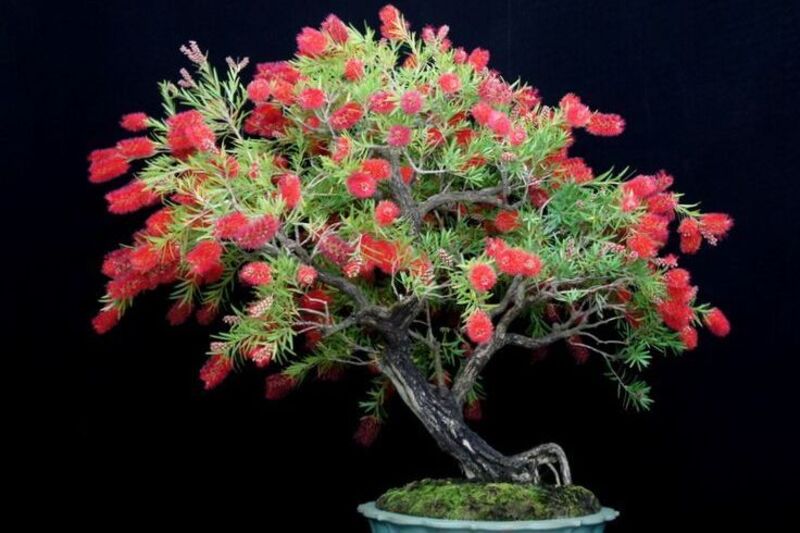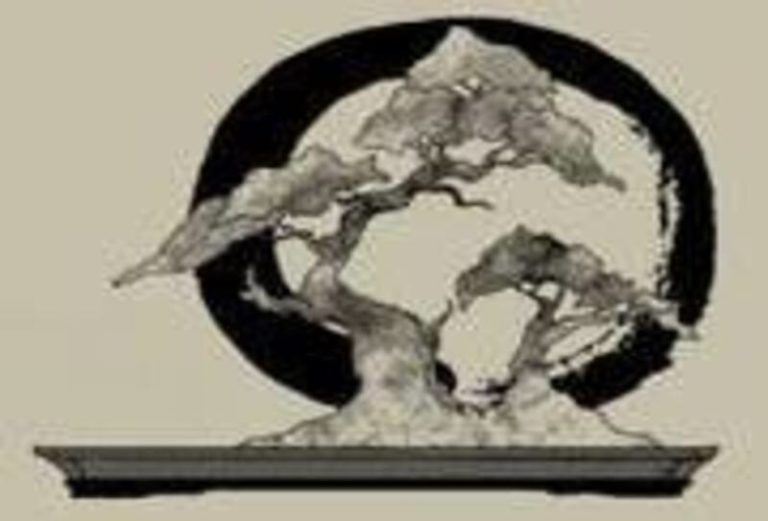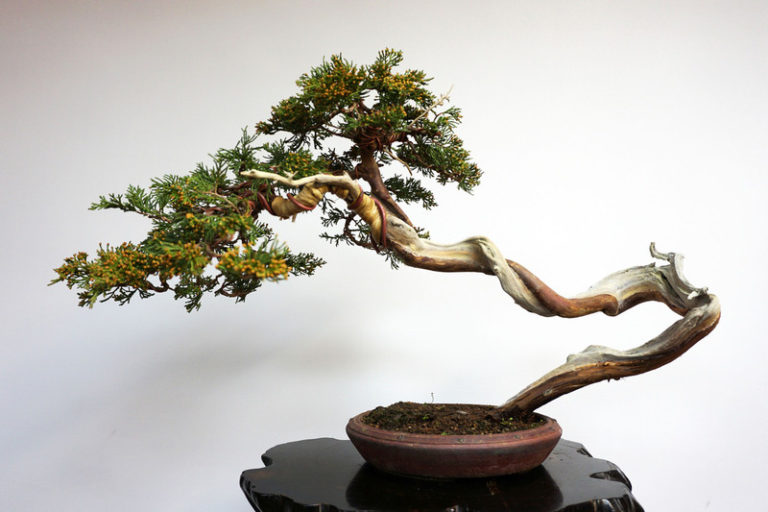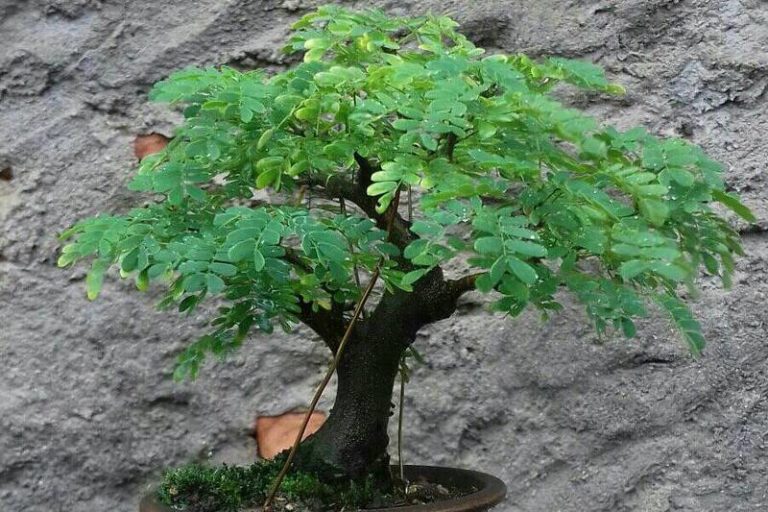Bottle Brush Bonsai : A Fascinating Bonsai Tree with Vibrant Flowers
Bottle brush bonsai is a unique and interesting art form in which tiny trees are grown and cared for. In this article, we’ll talk about the beauty and skill of bottle brush bonsai and show you how to grow and enjoy these lovely plants.
What is Bottle Brush Bonsai?
Bottle brush bonsai is the practice of growing and shaping miniature trees from the bottle brush plant, Callistemon. It involves pruning and training the tree to mimic the appearance of larger trees on a smaller scale. Bottle brush bonsai have unique features, including intricate branches and dense foliage. They hold cultural and symbolic significance, representing tranquility and the beauty of nature. Growing and caring for bottlebrush bonsai requires selecting a healthy tree and providing proper soil, a pot, watering, fertilizing, and sunlight. They can be displayed in various locations, bringing a touch of nature and serenity to any space.
History and Origins of the Bottle Brush Bonsai
The history and origins of bottle brush bonsai are intertwined with the broader art form of bonsai itself. Bonsai, which originated in China over a thousand years ago, involves the cultivation and shaping of trees in miniature form. The art form later spread to Japan, where it gained significant popularity and refinement.
The specific origins of bottle brush bonsai can be traced back to the bottle brush tree, scientifically known as Callistemon. Native to Australia, the bottle brush tree is named after its distinctive cylindrical flower clusters that resemble a bottle brush. It was introduced to bonsai cultivation due to its unique characteristics and visual appeal.
As bonsai enthusiasts sought to diversify the variety of trees used in the art, the bottle brush tree caught their attention. Its vibrant red flowers, attractive foliage, and ability to adapt well to bonsai cultivation made it a suitable candidate. The tree’s delicate branches and compact size made it ideal for creating miniature representations of larger, wild bottle brush trees.
Over time, bottle brush bonsai became a recognized style within the larger bonsai community. The artistry involved in shaping and training these miniature trees showcased the skill and creativity of bonsai practitioners. Bottle brush bonsai hold cultural significance, symbolizing tranquility, the beauty of nature, and the harmony between humans and the natural world.
Bottle brush bonsai are still liked and grown by bonsai fans all over the world. The art form has changed over time, and different methods and styles have been used to make beautiful tiny versions of the bottle brush tree. Through the art of bottle brush bonsai, the unique beauty and spirit of these trees are kept and praised.
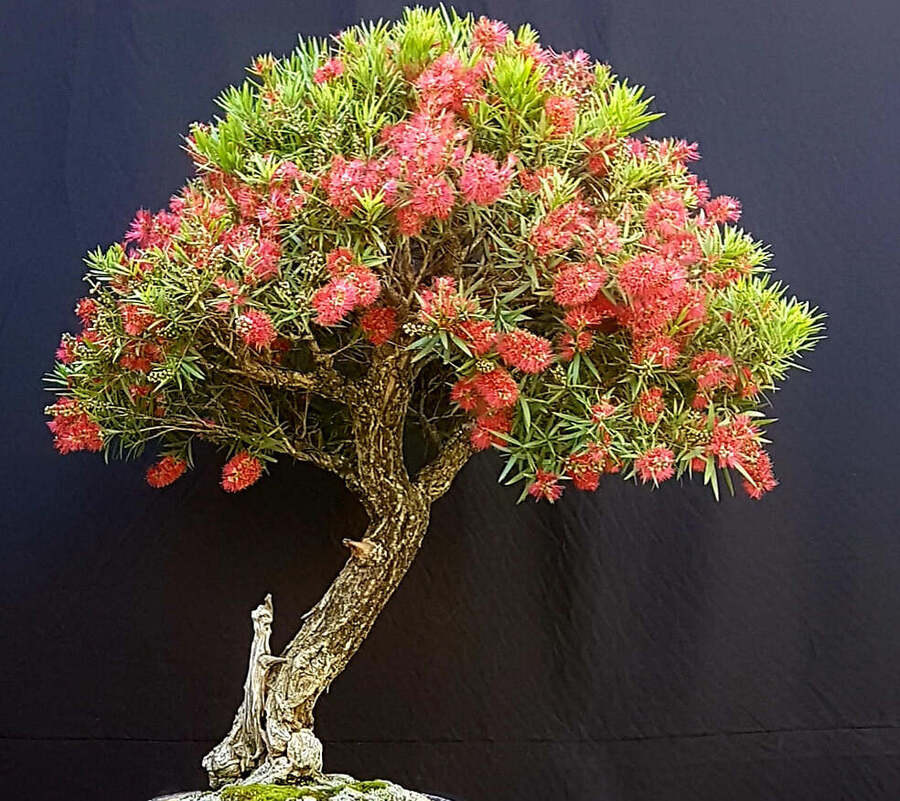
Bottle Brush Bonsai and Their Symbolism
Bottle brush bonsai trees hold symbolic meaning and significance in various cultures. Here are some common symbolic interpretations associated with bottle brush bonsai:
Tranquility and Serenity:
Like all bonsai trees, bottle brush bonsai symbolize peace, tranquility, and a connection with nature. Their presence can create a sense of calm and serenity in any space, making them popular choices for meditation gardens or indoor settings.
Beauty in Simplicity:
Bonsai, including bottle brush bonsai, is an art that shows how simple things can be beautiful. The small size and carefully made branches show that the artist appreciates simplicity and can find beauty in even the smallest details.
Balance and Harmony:
Bonsai represents the harmony between nature and human intervention. Bottle brush bonsai, with their carefully pruned and shaped forms, exemplify the delicate balance achieved through the collaboration between nature and the artist’s vision.
Endurance and Longevity:
Bonsai trees, including bottle brush bonsai, are often associated with longevity and endurance. The meticulous care and maintenance required to keep the trees healthy and thriving reflect their dedication and commitment to the preservation of life.
Resilience and Adaptability:
The bottle brush tree is known for being strong and able to change. As a bonsai, it represents the power and resilience of the human spirit by being able to survive and grow in tough situations.
Nature’s Beauty in Miniature:
Bottle brush bonsai show the true beauty of nature in a small and compact way. They remind us of the beauty and variety of the natural world and make us more appreciative of all the different parts of life.
The symbolism of bottle brush bonsai can vary across different cultures and individuals. Each person may interpret and connect with these trees in their own unique way, finding personal meaning and resonance with the art form. Ultimately, bottle brush bonsai invite us to pause, reflect, and celebrate the beauty and harmony found in the natural world.
Characteristics of the Bottle Brush Bonsai
Bottle brush bonsai trees, derived from the bottle brush plant (Callistemon), possess several distinctive characteristics that contribute to their visual appeal. Here are some key characteristics of bottle brush bonsai:
- Size: Bottle brush bonsai are small trees that are usually between a few inches and a few feet tall. Because they are small, you can put them inside or in a small place, like on a desk or tabletop.
- Foliage: The foliage of bottle brush bonsai consists of small, narrow leaves that are often dark green in color. The leaves grow densely, creating a lush and full appearance on the branches.
- Branching: Bottle brush bonsai trees have spreading designs that are both complicated and delicate. The branches are thin and usually respond well to shaping and wiring methods, which makes it possible to make many different kinds and designs of bonsai.
- Flowers: The bright and unusual flowers on bottle brush bonsai make them stand out. The bottle brush tree gets its name from its flower clusters, which look like bottle brushes. The flowers are usually bright red, but some of them may be pink, white, or yellow. These colorful flowers add a splash of color to the bonsai tree and make it more interesting to look at.
- Bark: The bark of bottle brush bonsai trees tends to have a smooth texture and a grayish-brown or reddish-brown coloration. As the tree ages, the bark may develop interesting patterns and textures, enhancing the overall aesthetic appeal.
- Shape and Style: Bottle brush bonsai can be trained and made into different styles, such as formal upright, which has a straight trunk with branches that get thinner and thinner, informal upright, which has a bent or slanted trunk, cascading, which has branches that hang down, and windswept, which has branches that are shaped by the wind. Because the branches are flexible, they can be used to show art and make unique bonsai shapes.
- Lifespan: If cared for and kept in good shape, bottle brush bonsai trees can live for a long time. They are often passed down from one generation to the next as family keepsakes. The fact that they last for a long time makes them more appealing and makes them worth growing.
These characteristics make bottle brush bonsai visually captivating and a popular choice among bonsai enthusiasts. The combination of miniature size, dense foliage, unique flowers, and graceful branching patterns makes them a delightful addition to any bonsai collection or as a focal point in interior décor.
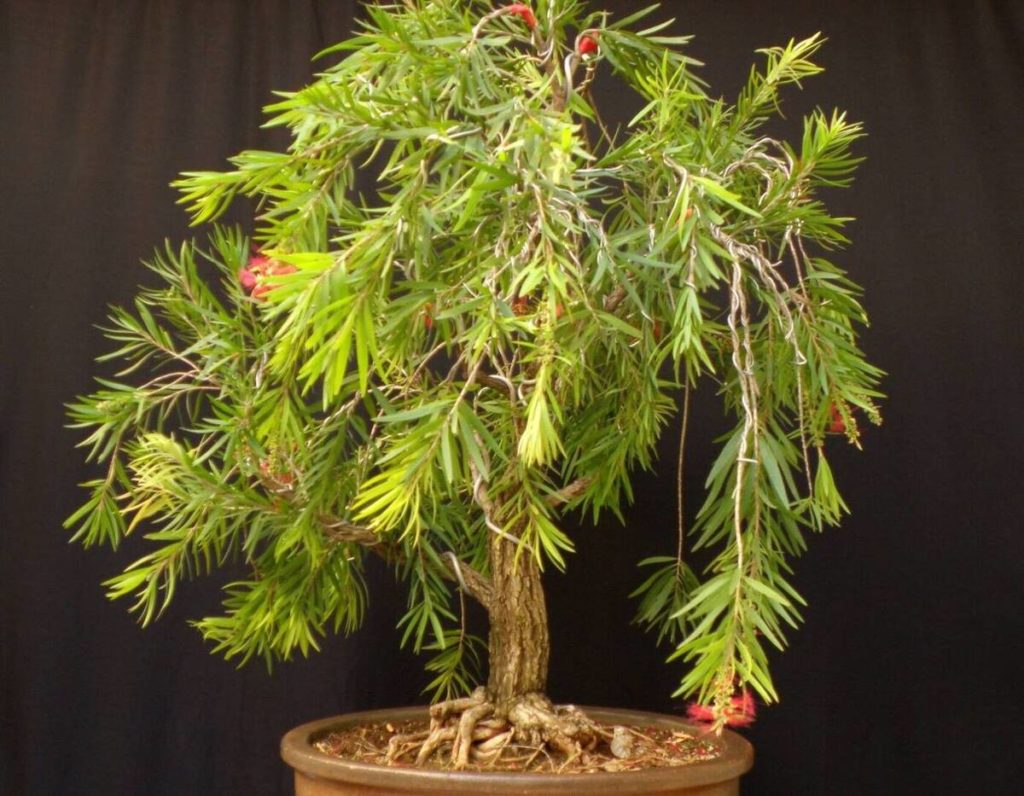
Types of Bottle Brush Bonsai
When it comes to bottle brush bonsai, there are different species and varieties of bottle brush trees (Callistemon) that are commonly used in bonsai cultivation. Here are a few types of bottle brush bonsai:
1. Callistemon citrinus:
Also known as the Crimson Bottlebrush or Lemon Bottlebrush, this species features bright red flowers and lemon-scented leaves. It is one of the most popular choices for bottle brush bonsai due to its striking color and attractive foliage.
2. Callistemon viminalis:
The Weeping Bottlebrush is a type with red flowers and branches that hang down. Its beautiful, flowing shape makes it good for making bonsai that look like they are falling or almost falling.
3. Callistemon rigidus:
This variety is commonly referred to as the Stiff Bottle brush or Woodland Bottle brush. It features stiff, upright branches and red or greenish-yellow flowers. Its unique branch structure and resilience make it an interesting choice for bonsai enthusiasts.
4. Callistemon sieberi:
This species, which is also called the River Bottlebrush, has thin branches and flowers that are either white or a light yellow. It isn’t used as often in bonsai, but its elegant look and soft colors can make for a peaceful and calming arrangement.
5. Callistemon subulatus:
The Dagger Bottle Brush, is a smaller species with fine, needle-like foliage and red or pink flowers. It is well-suited for creating compact bonsai designs or accenting larger compositions with its delicate appearance.
6. Callistemon salignus:
This species, which is often called the Willow Bottlebrush, has long leaves that look like willow leaves and flowers that are cream or white. Its branches are thin and graceful, which makes it a good choice for types of bonsai that stress beauty and a more natural look.
These are just a few examples of the types of bottle brush bonsai that enthusiasts can explore and cultivate. Each variety offers unique characteristics, such as flower color, foliage texture, and growth habits, allowing for a diverse range of artistic expressions within the realm of bottle brush bonsai.
How to Grow a Bottle Brush Bonsai
Growing a bottle brush bonsai requires attention to certain key steps and considerations. Here is a guide on how to grow a bottle brush bonsai:
Tree Selection: Start by selecting a healthy bottle brush tree from a reputable nursery or garden center. Look for a young tree with a well-developed root system and vibrant foliage.
Potting and Soil: Choose a well-draining bonsai pot that is appropriate for the size of your tree. Use a well-draining bonsai soil mix consisting of a combination of organic matter, such as peat moss or bonsai soil mix, and inorganic components, such as perlite or pumice. This ensures good water drainage while retaining some moisture.
Repotting: Every two to three years, in the early spring, you should repot your bottle brush bonsai. This helps to renew the earth, encourage healthy root growth, and keep the tree from getting stuck because of its roots. Before repotting, trim the roots and cut off any that are too long or broken.
Watering: Bottle-brush bonsai like soil that is just a little bit damp. Water the tree well enough to soak the earth, but don’t water it too much or let the water sit around the roots. Check the dirt often and change how often you water it based on how wet it is.
Sunlight: Bottle brush bonsai do best in full sun to partly shaded areas. Put your bonsai in a spot where it can get plenty of sunshine for at least a few hours every day. But keep the tree out of the strong noon sun, especially during the hot summer months.
Fertilization: During the growing season (spring to fall), use a balanced, slow-release bonsai fertilizer or an organic option to give the plant the nutrients it needs for good growth. Follow the directions from the maker for how much to use and how often.
Pruning and Shaping: Your bottle brush bonsai needs to be pruned regularly to keep its shape and size. Cut back any long shoots, cut off any dead or unhealthy branches, and use sharp, clean bonsai tools to form the tree. Wiring methods can also be used to move the branches into the right places.
Pests and Diseases: Keep an eye out for aphids, scale insects, or spider mites on your bottle brush bonsai. Use the right pesticides or natural treatments to get rid of any infestations right away. Make sure there is good air flow around the tree to stop fungal diseases, and don’t water it too much to prevent root rot.
Winter Care: Bottle brush bonsai are usually sensitive to frost, so if you live in a cold area, it is important to protect them during the winter. Move the bonsai indoors or give it enough cover to protect it from freezing weather.
Enjoyment and Maintenance: Keep an eye on your bottle brush bonsai and enjoy how it grows and changes. Keep up a regular care practice, such as watering, trimming, and fertilizing, to keep it healthy and help it live longer.
Remember that growing a bottle brush bonsai requires patience and ongoing care. With time, dedication, and a little artistic touch, you can cultivate a beautiful and captivating bottle brush bonsai that brings joy and tranquility to your space.
Benefits of the Bottle Brush Bonsai
The bottle brush bonsai, like other bonsai trees, offers several benefits to both the grower and the surrounding environment. Here are some key benefits of the bottle brush bonsai:
- Aesthetic Appeal: Bottle brush bonsai trees are visually captivating and add a touch of natural beauty to any space. Their miniature size, delicate branches, vibrant flowers, and lush foliage create an attractive and eye-catching display, whether placed indoors or outdoors.
- Stress Relief and Relaxation: It is known that bonsai, including bottle brush bonsai, can help people feel calm and relaxed. Taking care of bonsai trees can be a calming and meditative activity that gives you a break from the stress of everyday life.
- Indoor Decor: Bottle brush bonsai can be grown indoors, giving your home or office a touch of nature. Because of how small they are, you can put them on tables, shelves, or windowsills to enjoy the beauty of nature even in small places.
- Connection with Nature: Taking care of and growing a bottle brush bonsai is a way to connect with nature. It gives you a close-up look at how a live tree grows and changes, which helps you appreciate the beauty and complexity of nature.
- Artistic Expression: Growing bonsai, like bottle brush bonsai, is an art form that lets you show your creativity. People can show off their artistic skills and make unique live works of art by shaping and training trees in different bonsai styles and designs.
- Learning and Patience: To grow bottle brush bonsai, you need to know about gardening, bonsai methods, and the tree’s unique needs. It helps people keep learning, be patient, and pay attention to how the tree grows and changes, which helps them grow as people and learn new skills.
- Environmental Impact: Bonsai plants, including bottle brush bonsai, help the environment by cleaning the air, reducing noise pollution, and making homes for insects that are good for the environment. They also help keep the balance of nature and the variety of life in the area.
- Legacy and Tradition: Bottle brush bonsai can become treasured family treasures that are passed down through generations. Because these trees live for a long time, they can be used to create a living heritage that carries on the love and respect for nature and the art of bonsai.
Growing a bottle brush bonsai brings not only aesthetic enjoyment but also a sense of fulfillment and connection with nature. It offers an opportunity to explore creativity, learn about horticulture, and create a serene and captivating atmosphere in your living or working space.
Displaying and Showcasing the Bottle Brush Bonsai
Displaying and showcasing your bottle brush bonsai is an essential aspect of enjoying its beauty and sharing it with others. Here are some tips on how to effectively display and showcase your bottle brush bonsai:
1. Choosing the Right Location: Choose a spot for your bottle brush bonsai that looks good and goes with its style. Think about things like light, temperature, and humidity. Bottle brush bonsai do best in bright, indirect sunlight, so choose a spot near a window or in a well-lit area. Make sure the temperature and amount of humidity are good for the tree’s health and growth.
2. Bonsai Stands or Tables: Use bonsai stands or tables to elevate and showcase your bottle brush bonsai. These stands can be made of wood, metal, or other materials and come in various styles and sizes. Choose a stand that enhances the overall presentation of your bonsai and complements its aesthetic qualities.
3. Display Shelves: If you have more than one Bottle brush bonsai or a collection of bonsai, you might want to use shelves or racks to show them off. These are a neat and attractive way to show off your bonsai trees. They make the trees easy to see and create an engaging display.
4. Accent Elements: Enhance the visual impact of your bottle brush bonsai by incorporating accent elements. Small figurines, rocks, moss, or miniature sculptures can be strategically placed near or around the bonsai to create a more captivating and harmonious composition.
5. Rotation: Rotate your bottle brush bonsai often to make sure it grows evenly and to keep it from bending or getting branches that aren’t the same length. By turning the bonsai, all of the tree’s parts can get enough sunshine and grow in a healthy way.
6. Bonsai Exhibition or Show: Participating in bonsai exhibitions or shows provides an opportunity to showcase your bottle brush bonsai to a wider audience. These events allow bonsai enthusiasts to appreciate and learn from each other’s creations while also receiving feedback and insights from experienced bonsai artists.
7. Photography: Photograph your bottle brush bonsai to capture its beauty. High-quality images may be shared with friends, posted in social media sites, or entered into bonsai photography competitions. Photography helps you to chronicle your bonsai’s growth and development while also sharing its beauty with others.
8. Educational Opportunities: Consider hosting or going to bonsai classes or demos where you can show off your bottle brush bonsai and share your knowledge and experiences with others. This gives people who are interested in growing bonsais a chance to learn from and be inspired by others.
Remember, the way you display and showcase your bottle brush bonsai should reflect your personal style and taste. Experiment with different arrangements and settings until you find one that highlights the unique beauty and artistic qualities of your bonsai tree.
Styling and Design of a Bottle Brush Bonsai
The styling and design of a bottle brush bonsai are important aspects of creating a visually appealing and balanced composition. Here are some key considerations for styling and designing your bottle brush bonsai:
Bonsai Styles: Choose a bonsai style that suits the characteristics of your bottle brush bonsai and your personal preference. Common bonsai styles include formal upright (Chokkan), informal upright (Moyogi), slanting (Shakan), cascading (Kengai), and windswept (Fukinagashi). Each style has its own unique characteristics and aesthetic appeal.
Trunk and Branch Placement: Check out how the stem and branches of your bottle brush bonsai are set up. Aim for a trunk with a clear shape and a curving shape that gets thinner from the base to the top. Put the main branches at different heights and angles to make the tree look more interesting and deep. Make sure the stems are spread out properly and aren’t too close to each other.
Branch Pruning and Wiring: You should trim your bottle brush bonsai’s branches to get rid of any extra growth, long shoots, or branches that are crossing. This helps the tree keep its shape and keep its balance. Wiring can be used to guide and shape branches into the places that are wanted. Carefully use bonsai wire so it doesn’t cut into the wood or hurt the branches.
Apex and Canopy Design: Pay attention to the top of your bottle brush bonsai, which is called the apex. To make a perfect outline, the peak should be clear and in the right place. Trim and shape the leaves to make an umbrella that is balanced and looks good. Keep a mix between open places and dense foliage to make a composition that looks good.
Nebari (Root Spread): The nebari refers to the visible surface roots of the bonsai. Aim for a well-developed and radial nebari that radiates out from the base of the tree. Expose and accentuate the nebari by removing excess soil or using a root hook to gently tease out the surface roots.
Pot Selection: Choose a bonsai pot for your bottle brush bonsai that fits its style and size. Think about the pot’s color, shape, and material to make sure it goes well with the tree’s general design. Make sure the size of the pot lets the roots grow well and gives the bonsai support.
Patience and Continuous Refinement: The process of styling and creating a bottle brush bonsai is ongoing and requires patience and close attention. Check the tree’s growth, shape, and balance often and make any changes that are needed over time. Bonsai plants change and grow as they get older, so be ready to make changes to the design as the tree grows.
Don’t forget that making and creating a bottle brush bonsai is a creative process that lets each person show their own style. Accept the unique qualities of your tree and work with its natural shape to make an arrangement that is both striking and orderly. You can make a beautiful bottle brush bonsai that shows your artistic vision with time, experience, and hard work.
How to Care for and Maintain a Bottle Brush Bonsai
Caring for and maintaining a bottle brush bonsai involves several key aspects. Here are some essential care guidelines to keep your bottle brush bonsai healthy and thriving:
- Watering: Bottle brush bonsai like soil that is just a little bit damp. When the top dirt feels a little dry to the touch, give the tree a lot of water. Make sure that the pot doesn’t get too full of water, which can cause the roots to rot. Change how often you water based on the weather and time of year, but don’t overwater or let the dirt dry out totally.
- Sunlight: Put your bottle brush bonsai somewhere where it will get a lot of sunshine. These trees do best in places with full sun to some shade. Try to get at least a few hours of sunshine every day. But keep the tree out of the strong noon sun, especially in the hot summer months, because it can burn the leaves.
- Fertilization: Use a balanced, slow-release bonsai fertilizer or a liquid fertilizer made for bonsai to feed your bottle brush bonsai. Follow the manufacturer’s guidelines for how much to take and how often. Fertilize from spring to fall to give your plants the nutrients they need for good growth.
- Pruning: Your bottle brush bonsai needs to be pruned often to keep its shape and overall health. Take off any stems that are dead, sick, or crossing. Cut back long shoots to help the plant grow in a tidy and healthy way. cutting can be done at any time of the year, but heavy cutting should not be done when the plant is asleep.
- Leaf and Flower Maintenance: Bottle brush bonsais have bright flowers and lots of green leaves. Take off dead flowers to make room for new ones. Check the leaves often for signs of pests like aphids or spider mites, and if you find any, treat them right away with the right poisons or natural treatments.
- Repotting: Every two to three years, ideally in early spring, you should re-pot your bottle brush bonsai. Repotting lets you trim the roots, add more dirt, and get rid of extra roots. Use a bonsai soil mix that drains well when repotting to make sure the roots grow in the right way.
- Winter Care: Most bottle brush bonsai can’t handle freezing temperatures, so keep them out of the cold during the winter. Move the bonsai inside to a cool, well-lit place like a greenhouse or a window. You could also insulate the bonsai by wrapping the pot in insulated material or putting it in a protected area.
- Monitoring and Pest Control: Check your bottle brush bonsai regularly for signs of pests, diseases, or a lack of nutrients. Keep an eye out for aphids, scale insects, and spider mites, which are common bugs. Fix any problems right away using the right methods, or ask a neighborhood bonsai expert for help.
- Training and Wiring: As your bottle brush bonsai grows, you can shape and move the branches into the right places by wiring them. Be careful not to wire the twigs too tightly, because that can hurt them. Keep an eye on the wired branches on a regular basis to make sure they don’t get wire bites, and take the wire off before it cuts into the bark.
- Observation and Patience: Closely watch your bottle brush bonsai to learn what it needs and how it grows. For bonsai, you have to be patient and watch how the tree grows over time. Check on your bonsai’s health, shape, and balance often and make changes as needed.
By following these care guidelines, you can ensure the health and vitality of your bottle brush bonsai. Remember that each bonsai is unique, and it may require slight adjustments to the care routine based on its specific needs. Enjoy the process of caring for your bottle brush bonsai and appreciate the beauty and tranquility it brings to your space.
Bottle Brush Bonsai Care Sheet
| Aspect | Care Tips |
| Watering | – Water thoroughly when the topsoil feels slightly dry. |
| – Avoid overwatering or letting the soil dry out completely. | |
| Sunlight | – Place in a location with ample sunlight (full sun to partial shade). |
| – Protect from intense midday sun to prevent leaf scorching. | |
| Temperature | – Keep in a moderate temperature range (ideal range: 60-80°F). |
| – Protect from frost or freezing temperatures in winter. | |
| Humidity | – Bottle brush bonsai prefer average humidity levels. |
| – Mist the foliage occasionally to increase humidity if needed. | |
| Fertilization | – Feed with a balanced, slow-release bonsai fertilizer. |
| – Follow recommended dosage and frequency instructions. | |
| Pruning and Trimming | – Regularly prune dead, diseased, or crossed branches. |
| – Trim back long shoots for a compact and balanced growth. | |
| Wiring and Styling | – Use wiring techniques to shape and guide branches. |
| – Avoid wiring too tightly to prevent damage. | |
| Repotting | – Repot every 2-3 years in early spring. |
| – Prune roots, replenish soil, and use well-draining mix. | |
| Pest and Disease Control | – Regularly inspect for pests and diseases. |
| – Treat issues promptly with appropriate methods. | |
| Winter Care | – Protect from freezing temperatures by moving indoors. |
| – Provide insulation or shelter in colder months. | |
| Regular Maintenance | – Continuously observe the health and growth of the bonsai. |
| – Make adjustments to care routine as needed. |
Remember that these care tips serve as general guidelines, and it’s essential to observe and understand the specific needs of your bottle brush bonsai as it grows. Adjust the care routine based on the individual characteristics and requirements of your tree. Regularly monitoring and providing appropriate care will help ensure the long-term health and vitality of your bottle brush bonsai.
Conclusion
Bottle brush bonsai is a fascinating and satisfying art form that lets you bring the beauty of nature into your home or yard. By following the tips in this piece, you can start growing and enjoying these amazing little trees. Remember to love and care for your bottle brush bonsai, and watch it grow into a live work of art.
FAQ:
Q: What is Bottle Brush Bonsai?
A: Bottle Brush Bonsai, also known as Callistemon, is a type of bonsai tree that belongs to the Myrtle family. It is named for its unique cylindrical flowers that resemble bottle brushes. These bonsai trees are known for their vibrant red or pink flowers and needle-like foliage.
Q: How tall does a Bottle Brush Bonsai grow?
A: Bottle Brush Bonsai can grow up to 3-6 feet (0.9–1.8 meters) in height, depending on the species and how it is pruned and maintained as a bonsai.
Q: What are the care requirements for Bottle Brush Bonsai?
A: Bottle Brush Bonsai requires moderate watering, well-draining soil, and a location with ample sunlight. They prefer temperatures between 60 and 80°F (15 and 27°C) and average humidity levels. Regular pruning, fertilization, and protection from frost are also important for their care.
Q: How often should I water my Bottle Brush Bonsai?
A: Water your Bottle Brush Bonsai thoroughly when the topsoil feels slightly dry. Avoid overwatering, which can lead to root rot, and make sure the excess water drains out of the pot.
Q: Does Bottle Brush Bonsai require full sun?
A: Bottle Brush Bonsai thrives in full sun to partial shade conditions. It is recommended to place them in a location where they can receive at least a few hours of direct sunlight each day.
Q: When should I fertilize my Bottle Brush Bonsai?
A: Fertilize your Bottle Brush Bonsai during the growing season (spring to autumn) using a balanced, slow-release bonsai fertilizer or a liquid fertilizer specifically formulated for bonsai. Follow the recommended dosage and frequency instructions provided by the manufacturer.
Q: Can I wire and style my Bottle Brush Bonsai?
A: Yes, you can wire and style your Bottle Brush Bonsai to achieve the desired shape and form. Use wiring techniques to guide and position the branches, but be careful not to wire too tightly to avoid damaging the branches.
Q: How often should I repot my Bottle Brush Bonsai?
A: Repot your Bottle Brush Bonsai every 2-3 years, preferably in the early spring. This allows for root pruning, replenishing the soil, and maintaining a healthy root system.
Q: Are there any common pests or diseases that affect Bottle Brush Bonsai?
A: Bottle Brush Bonsai can be susceptible to pests such as aphids, scale insects, and spider mites. Regularly inspect the tree for signs of pests and treat them promptly with appropriate insecticides or natural remedies. Proper care and maintenance can help prevent common diseases.
Q: How should I care for my Bottle Brush Bonsai during the winter?
A: Protect your Bottle Brush Bonsai from freezing temperatures during the winter by moving it indoors to a cool and well-lit area, such as a greenhouse or a bright window. You can also provide insulation by wrapping the pot with insulating material or placing the bonsai in a sheltered location.
Also Read:

